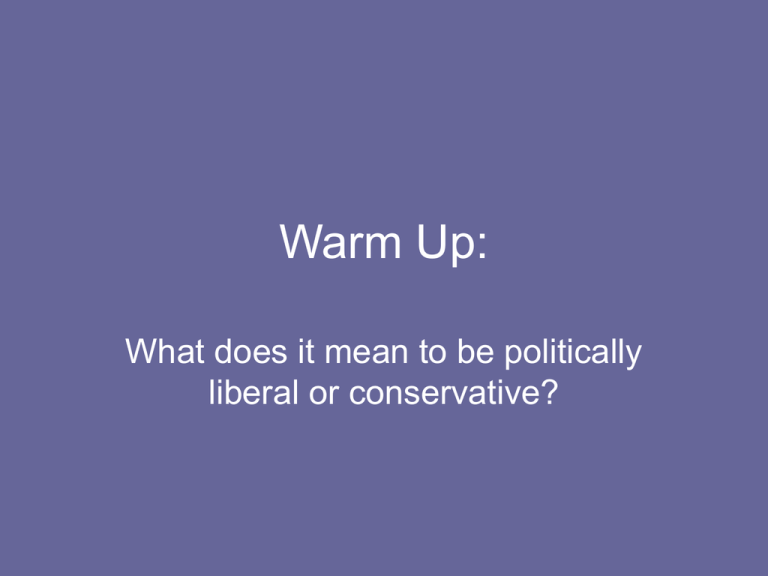Electoral System
advertisement

Warm Up: What does it mean to be politically liberal or conservative? What are political characteristics of conservatives? What are political characteristics of liberals? Conservative or Liberal? • Which political party is associated with conservatives? • Which political party is associated with liberals? Chapter 10 Section 1 A Two-Party System Political Party • A group of citizens with similar views on public issues who work together to put their ideas into effective government action. What do Parties Do? • Link between people and government • Develop policy • Bring conflicting groups together Functions of Parties • Nominating, or selecting candidates • A candidate is a person who is running for political office - help candidates win office Functions of Parties • Political parties take different positions on key public issues • Based on their political views parties can be placed along the political spectrum. • The political spectrum refers to the range of differences in political views between parties. What are the political parties in the U.S.? Who are Chuck Baldwin, Cynthia McKinney, Bob Barr, and Ralph Nadar? •What do they have in common? Answer: All were candidates in the last Presidential election. Two Party System • In the United States we have two main political parties. • Democratic Party is generally more liberal • Republican Party is generally more conservative Why does the U.S. have Two Major political parties? • Historical Basis - Federalist and Anti-Federalist - Nation began with a two-party system, it has maintained a two-party system Why does the U.S. have Two Major political parties? • Electoral System Single-member districts- one candidate is elected to each office on the ballot “Winner take all elections” - Winning candidate receives plurality, or most votes - Discourages minor parties “Wasted vote” Warm Up: What is the role of political parties? Review HW pg 254 • IB- How might a political party convince voters to vote for its candidate? • 2B-what are some reasons why Americans citizens might reject a one-party system? • 3B-How might a third party candidate win the presidency? Why does the U.S. have Two Major political parties? • Electoral System - Two major parties work together to shape election laws to preserve two-party system - Difficult for independents and minor party candidates to get on ballot • Minor Party candidates have only made it ballots in all 50 states in just 7 presidential elections Alternatives to the Two-Party System • Multiparty System • Common in Europe - Several major and many lesser parties compete for, and win elections - Parties based on a particular interest such as: economic class, religion, sectional attachment, political ideology Alternatives to the Two-Party System • Multiparty System • Benefits: Broader representation of the electorate • Weaknesses: Instability - One part often unable to win support of majority - Must form coalition (temporary alliance) with other parties to form working majority to control gov’t - If coalition shifts or dissolves, “new governments” must be created Alternatives to the Two-Party System • - One Party System Only one political party is allowed “no party” system Called dictatorships or totalitarian governments • In some U.S. states, one party dominates politics, creating modified one-party systems • Can you think of any regions or states where one political party is dominant? 2000 Election Red= Republican states Blue=Democratic States 2004 Election Red= Republican states Blue=Democratic States 2008 Election Red= Republican states Blue=Democratic States Party Membership • How do you choose what political party you want to join? • Do you have to choose to be part of a political party? Types of Minor Parties 1. Ideological Parties • Based on a particular set of beliefs, comprehensive view of social, economic and political matters. • Examples: Socialist, Communist, Libertarian Types of Minor Parties 2. Single Issue Parties • Focus on one public policy matter - Events pass them by, major party takes up the issue • Examples: Free Soil Party, Right to Life Party Types of Minor Parties 3. Economic Protest Party • Focus on anger at economy, not ideas - Often sectional - Fade away as economy improves • Examples: Greenback Party, Populist Party, Tea Party Types of Minor Parties 4. Splinter Parties • Broke away from major parties • Form around a strong personality • End when leader dies • Examples: Bull Moose Party, Progressive Party, State’s Rights Party, American Independent Party Why important? • “spoiler role”- pull votes from a major party 1912 Election Woodrow Wilson- Democrat 42% Theodore Roosevelt- Progressive 27% William Taft – Republican 23% Eugene Debs- Socialist 6% Why important? • “spoiler role”- pull votes from a major party 1992 Election Bill Clinton – Democrat 42% George Bush – Republican 37 % Ross Perot – Independent 19% Why important? • Critics- willing to take stand on controversial issues - Draw attention to issues











